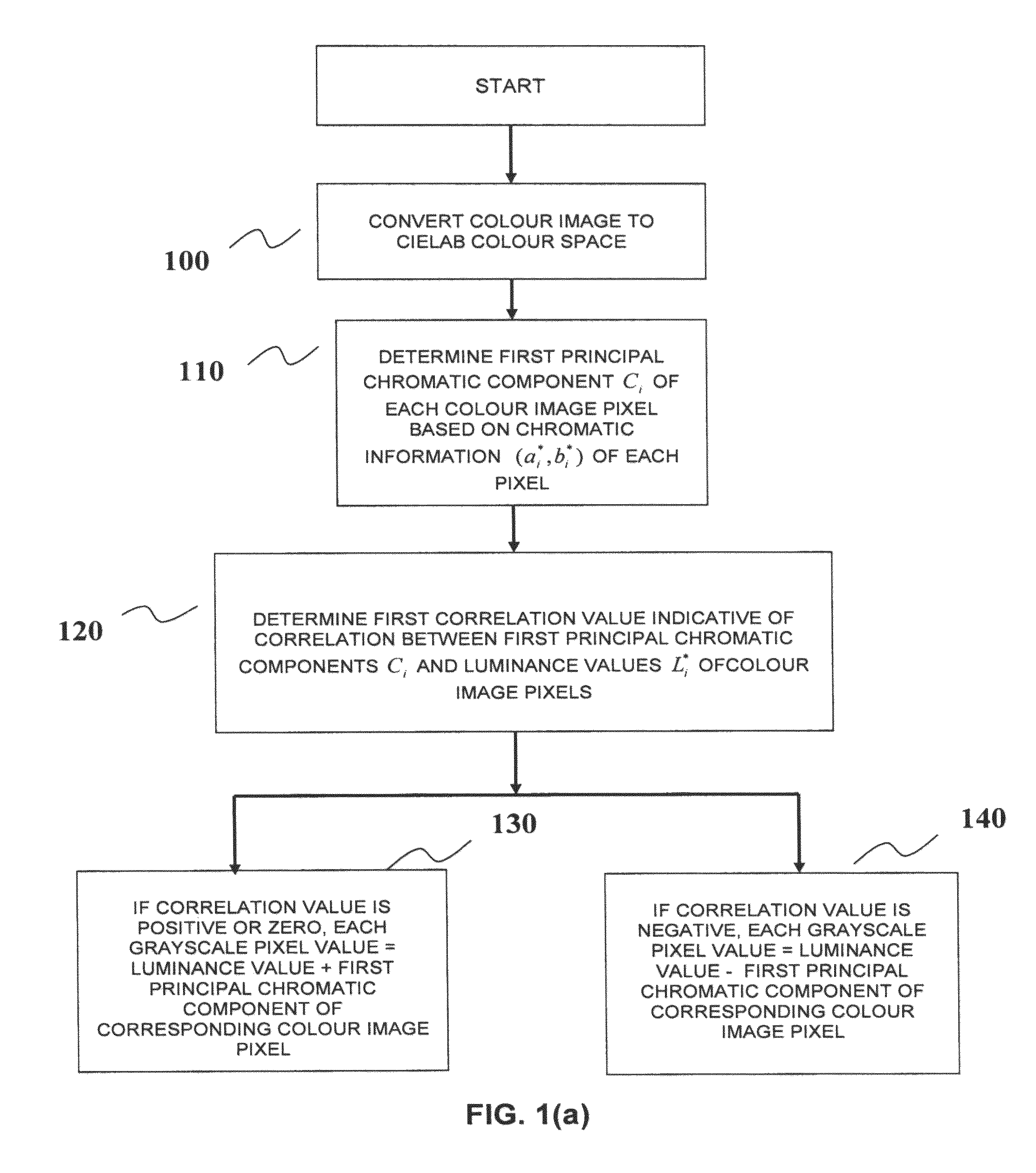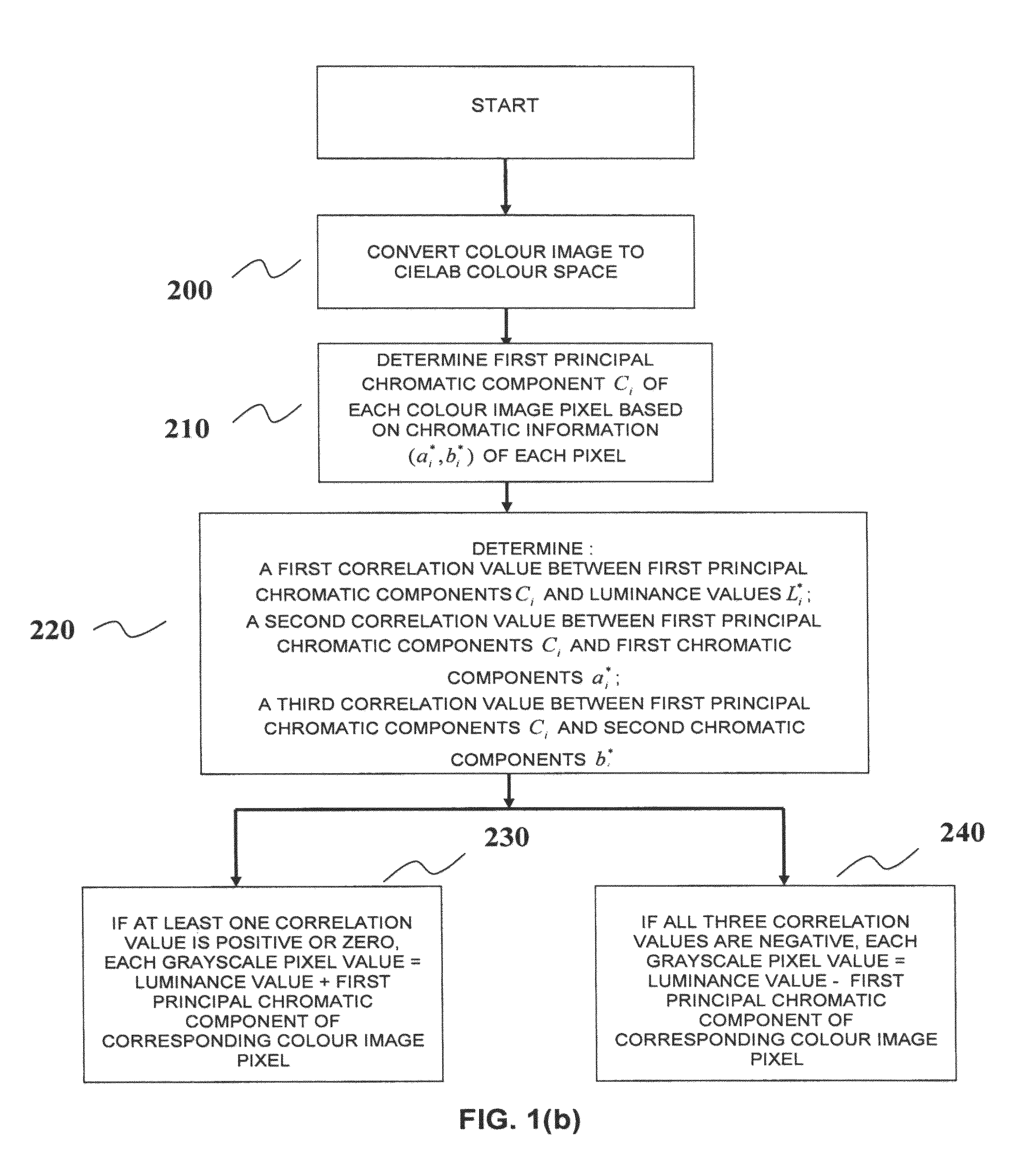Method and device for use in converting a colour image into a grayscale image
a technology of color image and grayscale image, which is applied in the direction of color signal processing circuits, instruments, television systems, etc., can solve the problems of visual contrast, colour image may not be readily visible or distinguishable in the resulting grayscale image, and is unsuitable for use real-time applications such as printing
- Summary
- Abstract
- Description
- Claims
- Application Information
AI Technical Summary
Benefits of technology
Problems solved by technology
Method used
Image
Examples
example i
[0103]FIG. 6(a) shows a second colour image which is to be converted into a grayscale image using the CLPC algorithm, the Decolorize algorithm and the C2GB0-1 algorithm for the purposes of illustrating the performance enhancement of the CLPC algorithm.
[0104]In converting the colour image into a grayscale image, it is desirable to provide a high contrast between the numbers “2” and “5” relative to the background.
[0105]FIG. 6(b) shows a grayscale image which may be typically generated by pre-existing image conversion algorithms in which only the luminance values of each colour image pixel is used to form the grayscale image. It would be readily apparent to a person skilled in that art that the numbers “2” and “5” in FIG. 6(b) are not suitably defined and poorly contrasted.
[0106]The grayscale images shown in FIGS. 6(g) and 6(h) which have been produced using the C2GB0-1 and Decolorize conversion algorithms respectively exhibit relatively poor contrasts between the numbers “2” and “5” a...
example ii
[0112]The CLPC algorithm was further applied to the exemplary colour image shown in FIG. 9(a) to provide the resulting grayscale image shown in FIG. 9(e).
[0113]In performing the conversion, the CLPC algorithm calculates the {Li*} and (ai*,bi*) in a CIELAB colour space from RGB components, and a correlation matrix for computing first principal chromatic components. In total, O(η2) operations are approximately required to process a colour image of size η×η in accordance with the CLPC algorithm. It would be readily appreciated by a person skilled in the art that this is a practicable processing time in the context of real-time printing.
[0114]FIG. 9(f) shows a comparative table indicating the results of the CLPC, C2GB0-1 and Decolorize algorithms in converting the colour image into a grayscale image. The table shows that the grayscale values of specific regions in each of the resulting grayscale images together with an indication of the relative differences in grayscale values in specif...
example iii
[0118]Further tests of the first embodiment algorithm have been applied to the computer-generated image shown in FIG. 10(a). The colour image contains many different colours and it would be difficult for the converted grayscale image to preserve all the colour contrasts. Moreover, there are three coloured lines in different colours (red, green and blue) in which colours change smoothly in their corresponding regions.
[0119]FIG. 10(b) shows only the luminance values of pixels in the colour image of FIG. 10(a) resulting in a pronounced edge artefact indicated by “D”. Moreover, it is apparent from an examination of the resulting grayscale images in FIGS. 10(c) and 10(d) produced by C2GB0-1 and Decolorize algorithms respectively, that they tend to retain, if not enhance, this artefact.
[0120]In contrast, FIG. 10(e) which represents the resulting grayscale image produced by converting the colour image in FIG. 10(a) using the CLPC algorithm, shows more gradual changes in gray scale values. ...
PUM
 Login to View More
Login to View More Abstract
Description
Claims
Application Information
 Login to View More
Login to View More - R&D
- Intellectual Property
- Life Sciences
- Materials
- Tech Scout
- Unparalleled Data Quality
- Higher Quality Content
- 60% Fewer Hallucinations
Browse by: Latest US Patents, China's latest patents, Technical Efficacy Thesaurus, Application Domain, Technology Topic, Popular Technical Reports.
© 2025 PatSnap. All rights reserved.Legal|Privacy policy|Modern Slavery Act Transparency Statement|Sitemap|About US| Contact US: help@patsnap.com



